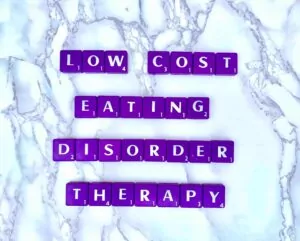Affordable Eating Disorder Therapy
Update June 2021: We are so excited to have our own in-house option for low-fee eating disorder therapy for people in California with our graduate externs.
Eating Disorders Affect People at All Income Levels
This NEDAwareness week (2018), I’ve been thinking a lot about the theme of “Let’s Get Real.” One stubborn myth about eating disorders is that they affect primarily white, upper-middle-class females.![low cost eating disorder treatment Los Angeles County and California | 90057 | 90059 | 90063 | 90066 low-cost eating disorder counseling Los Angeles County at Eating Disorder Therapy LA and online in California [Image description: image of the lights at LAX airport lit for Eating Disorder Awareness Week]](https://www.eatingdisordertherapyla.com/wp-content/uploads/2018/02/low-cost-eating-disorder-treatment-Los-Angeles-County-sm-300x225.jpg)
It would take you just one afternoon at my own Los Angeles eating disorder practice to discover how untrue this is. My clients are all genders, ages, and ethnicities. We are proud to accept some private insurance and some public insurance. Among our patients with eating disorders are non-native English speakers, immigrants from low SES backgrounds, and people on public assistance.
The myth that eating disorders affect only the wealthy not only makes it more difficult for patients who don’t meet the stereotype to recognize that they have a problem but also affects the entire system of treatment.
Throughout the US, there is a shortage of publicly funded specialized treatment programs for eating disorders. Specialized eating disorder treatment is usually expensive! The residential treatment complex only serves the economically privileged.
Carolyn Becker, Ph.D. recently brought attention to the presence of eating disorders in food-insecure populations. The research on which she collaborated studied adults receiving food at San Antonio area food banks. Those who had hungry children in their households (representing higher levels of food insecurity) had higher levels of binge eating, dietary restraint, weight self-stigma, worry, and overall eating disorder pathology when compared to participants with lower levels of food insecurity
Los Angeles County Lacks Eating Disorder Treatment for People With Low Income
Within Los Angeles County, eating disorders are a covered diagnosis by the Department of Mental Health (DMH). However, according to a DMH district chief, there are no specialized services for eating disorders within the DMH system. I recently led a training on eating disorders at one of the county community mental health centers and a staff member there told me, “Most patients with eating disorders are seen in primary care and none of us are trained specifically in this… What we need is training in evidence-based treatment.”

I searched the Alliance for Eating Disorder Awareness list of Medicare/Medicaid providers and facilities within 50 miles of Los Angeles but came up with only one Medicare provider and no Medicaid providers or facilities.
This blog post was inspired because as a provider for Anthem Medi-Cal and Carelon Medi-Cal, we often receive calls from county clinics with referrals of other (non-Anthem/non-Carelon) Medi-Cal patients with eating disorders with whom we are are not in-network. So, when faced with a patient with an eating disorder and no insurance in LA County, what’s a provider to do? Here’s what we’ve been able to find. If you have other resources, we’d love to hear about them!
Low-Income Resources For Eating Disorders in Los Angeles
Hospitals
CHLA takes California Medicaid for patients under age 25 needing medical stabilization.
UCLA takes California Medicaid for patients under age 25 needing hospitalization for eating disorders.
General Low-Fee Mental Health Clinics
Southern California Counseling Center
Maple Counseling Center
The Wright Institute
Cal Lutheran Low Fee Counseling Center
Treatment Scholarships
Center for Discovery and Project Heal provide treatment scholarships. We also provide 2 free spots per year through our membership with Project Heal Healer’s Circle.
Get Low-Cost Therapy for an Eating Disorder in California
Our graduate externs, working under our licensed psychologists provide psychotherapy to adults in California with eating disorders and disordered eating. To get started, complete the contact form on our website.
Learn More About Using Insurance for Eating Disorder Counseling in California
Our staff therapists accept Anthem, Aetna, Anthem Med-Cal, Carelon, Kaiser, and Lyra Insurances for clients with eating disorders in California.
Source
Becker, Carolyn Black, Keesha Middlemass, Brigitte Taylor, Clara Johnson, and Francesca Gomez. 2017. “Food Insecurity and Eating Disorder Pathology.” International Journal of Eating Disorders 50 (9): 1031–40. https://doi.org/10.1002/eat.22735.
Thanks to Rosewood Center Santa Monica for help with the referral list.
![Psychotherapy counseling fees in Los Angeles, California [Image description: drawing of money sitting on a lavender table] Represents the cost of psychotherapy sessions in Los Angeles, California](https://www.eatingdisordertherapyla.com/wp-content/uploads/2023/05/DALL·E-2023-05-19-10.16.34-a-drawing-of-paper-money-of-several-different-type-of-bills-scattered-on-a-purple-table111-300x300.png)